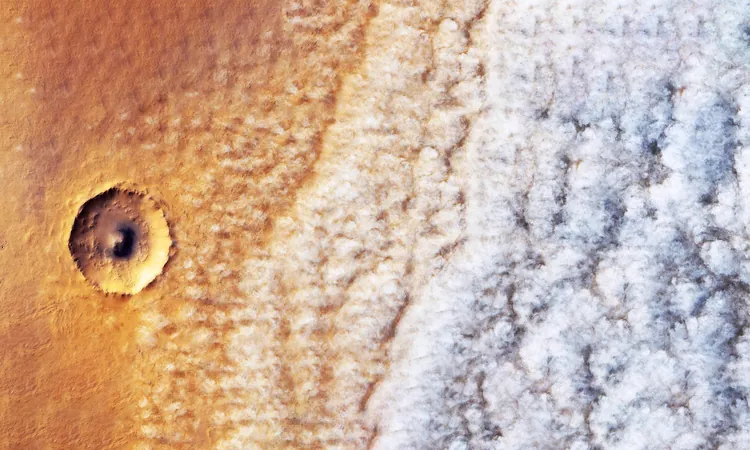
Spectacular Glowing Clouds on Mars: A Breathtaking Martian Phenomenon Unraveled!
2025-01-16
Author: Ying
Seasonal Marvels on Mars
Curiosity has recently shifted its focus to two wintery sites, aptly named Snow Creek and Winter Creek. This strategic maneuver allows scientists to conduct ground-breaking research while drilling into Martian rocks to uncover secrets of the planet’s atmospheric history. The rover's team has prioritized remote imaging of formations both near and far, utilizing its ChemCam to analyze rock compositions and employing cameras to capture intriguing bedrock structures. The aim? To understand how clouds and dust storms contribute to shaping Mars' environmental conditions. Dr. Daniela Tirsch from the German Aerospace Center highlights the spectacle, stating, “We also see impressive dust clouds that can spread hundreds of kilometers,” indicating just how dynamic the Martian atmosphere can be throughout seasons.
Unlocking the Martian Cloud Atlas
Scientists have compiled an impressive "Cloud Atlas," documenting the evolution of Martian clouds through thousands of images captured over the past two decades by orbiters like Mars Express. The findings reveal that clouds on Mars exhibit a remarkable diversity, akin to those found in Earth's atmosphere but uniquely tinted by the thin air that envelops the Red Planet. Among these atmospheric phenomena, the intriguing “cloud streets,” resembling endless corridors in the sky, have been eye-opening for researchers.
The Enigmatic High-Altitude Clouds
Mars plays host to water-ice clouds that can form at elevations reaching up to 60 miles (100 km). These ethereal wisps glow magically in twilight photographs, illuminated by sunlight that dances off them long after setting below the horizon. Researchers have likened these clouds to Earth’s noctilucent clouds—delicate, glowing formations that capture the imaginations of sky gazers. Interestingly, some Martian clouds contain carbon dioxide crystals and typically form in the colder reaches of the upper atmosphere. Their presence adds complexity and intrigue to Mars' meteorological behavior.
Why Dust Is Key to Understanding Martian Weather
Dust storms are another critical aspect of Martian meteorology. These swirling tempests can rise to staggering heights, influencing ground temperatures and providing orbital insights into ongoing atmospheric patterns. Observers from orbit have witnessed storms that can shroud entire hemispheres in mere days! During Mars' southern autumn and winter, the atmosphere becomes even more turbulent, leading to dramatic dust curtains that can be detected from orbit.
The Lifespan of a Martian Cloud
Most clouds on Mars originate from trace amounts of vapor (primarily carbon dioxide along with a hint of water) that cling to dust particles. With Mars having far less moisture compared to Earth, these ice crystals tend to be delicate yet impactful, influencing the planet's climatic equilibrium. Water-ice clouds often cluster around volcanoes, propelled by updrafts, while some develop into remarkable elongated plumes near iconic formations like Arsia Mons that both form and dissolve with astonishing rapidity.
Curiosity’s Ground-Level Perspective
From the surface, Curiosity captures glimpses of clouds gliding above—nuggets of information that orbiters might miss, such as the rapid movement of passing clouds and intricate details of swirling dust events. Despite Mars' silent terrain, the skies above are alive with activity: dust devils dance across crater floors, while newly formed clouds infuse the sunrise with color.
Fresh Insights on Martian Weather
Data from these magnificent ice clouds and far-reaching dust storms continue to shed light on the Red Planet’s meteorological patterns. Observations of how clouds interact with seasonal changes are evolving our overall understanding of Martian weather systems. As missions with rovers and orbiters persist, more insights into the complex interactions between water vapor, dust, and thermal fluctuations are expected. Each image taken and measurement recorded contributes vital clues to revealing the long history of Martian climate. Stay tuned for more cosmic discoveries! Mars never ceases to amaze.



 Brasil (PT)
Brasil (PT)
 Canada (EN)
Canada (EN)
 Chile (ES)
Chile (ES)
 Česko (CS)
Česko (CS)
 대한민국 (KO)
대한민국 (KO)
 España (ES)
España (ES)
 France (FR)
France (FR)
 Hong Kong (EN)
Hong Kong (EN)
 Italia (IT)
Italia (IT)
 日本 (JA)
日本 (JA)
 Magyarország (HU)
Magyarország (HU)
 Norge (NO)
Norge (NO)
 Polska (PL)
Polska (PL)
 Schweiz (DE)
Schweiz (DE)
 Singapore (EN)
Singapore (EN)
 Sverige (SV)
Sverige (SV)
 Suomi (FI)
Suomi (FI)
 Türkiye (TR)
Türkiye (TR)
 الإمارات العربية المتحدة (AR)
الإمارات العربية المتحدة (AR)